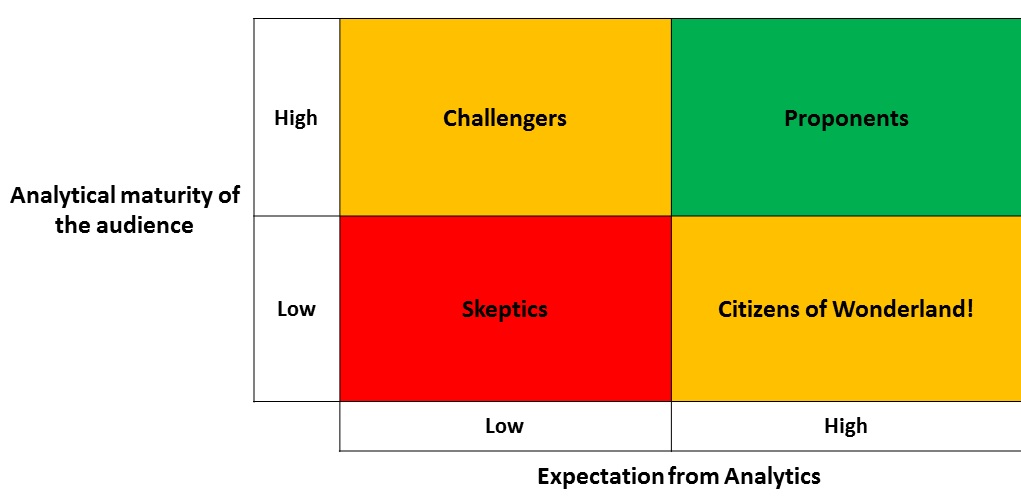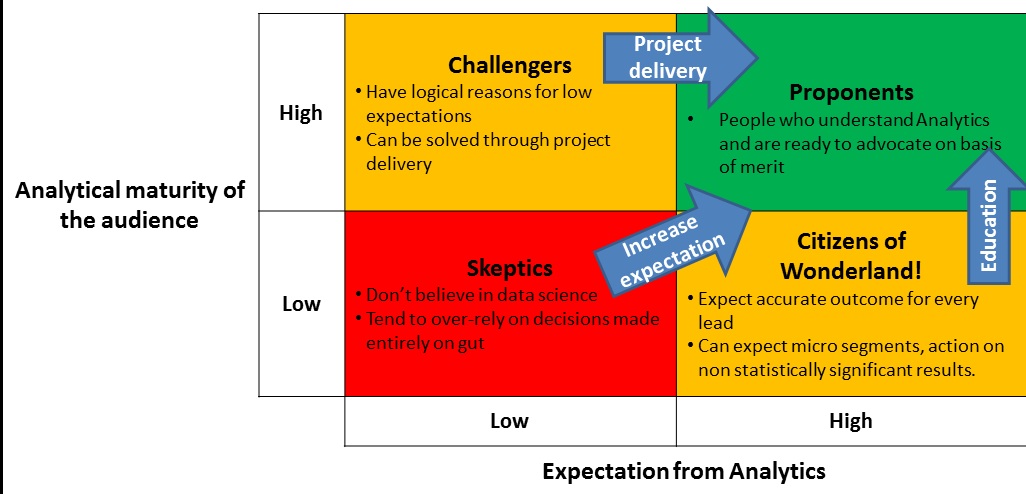According to a survey conducted by Bloomberg in 2011 (on companies exceeding $100 Mn in revenues), 97% of these companies have embraced Analytics in some form. However, only one in four organizations believes its use of business analytics has been “very effective” in helping to make decisions.
This gap in investment and desired results might be higher in developing markets like India. While, there are bunch of reasons which contribute to this gap, one of the key reason contributing to this gap is effective customer management.
There are various kinds of customers we interact with, while working on analytical projects. They possess different understanding of analytics and have varied expectations from it. Keeping a similar engagement with these customers is like preparing for a disaster.
Over last few years, I have developed a segmentation which I have found very useful while interacting with various customers. This segmentation not only helps you on how to best interact with various customers, but also lays maps these customers on a journey to convert them into proponents of Analytics.
[stextbox id=”section”]Segmentation of Analytics customers:[/stextbox]
Following is the segmentation I use for engaging with customers (In case you want to read more on Segmentation & how to create one, click here):
The customers are divided in 4 categories basis their understanding / maturity about Analytics and the potential they see in Analytics. Following is a brief description of each of this dimension:
- Analytical maturity of the audience: This dimension represents customer’s understanding about how Analytics can contribute to decision making. A customer with high maturity would not only understand what Analytics can deliver, but also what it cannot.
Some examples of aspects which I expect an analytically mature customer to understand are:
- What is predictive modeling (from business point of view) and how can it help a business?
- Does the customer understand what efforts will it take to implement a project?
- There is a minimum sample size required for performing any analysis and pulling out recommendations.
- How open is the customer to the idea of testing?
- Does the customer understand the difference between Analysis and reporting?
- Expectation from Analytics: By expectation, I mean the point of view a person carries towards analytical projects and thinking. A few questions which can help us map a customer on this dimension are:
- What kind of benefits does the customer expect from Analytics? How critical are they to his function?
- What kind of time frame does the customer have in mind for getting these benefits?
- Is the customer looking forward to project implementation or he is implementing it under some pressure?
Once you map your customers on these 2 dimensions, they can fall in any of these 4 categories:
[stextbox id=”section”]Analytics Proponents:[/stextbox]
These are the group of customers who understand what Analytics can deliver and would be ready to advocate the practice in the Organization. These are the people who will come to you with specific and clearly defined problems, would be ready to collaborate / spend time and finally implement the solution. If you have any customer who falls under this category, you should make sure that you deliver / over-deliver on these projects. Hopefully, they will help you increase Analytics penetration in future through their influence.
[stextbox id=”section”]Challengers:[/stextbox]
Challengers are people who understand Analytics, but are not convinced that it can deliver on the projects in Organization. The best way to start engagement with them is to try and have an open discussion with them and understand their concerns. Being aware of these concerns would be the first step in alleviating them.
There are times when it would not be possible to have this discussion and even if it happens, it may not be entirely honest (especially if it is early in the engagement). In that scenario, the best way is to take up small but impactful projects and deliver them. Once the customers see some delivery, they would start their journey to become a proponent.
[stextbox id=”section”]Citizens of wonderland:[/stextbox]
These are often amusing group of customers. They don’t understand nuances of Analytics completely, but carry high expectations from Analytics. While in short term, these customers are easy to interact, the difference in expectation and maturity will cause difficulties in long term.
Some of the situations you will find yourself with these customers are:
- How can Highest propensity leads of a campaign not convert? (vs. Why is the conversion rate of Highest propensity leads lower than expected?)
- We have arrived at these recommendations after a lot of analysis and discussions, lets implement it on entire population (vs. we should test our recommendation to size the benefit and understand whether the recommendations work or not?)
How to interact with these customers?
Educating them about Analytics might be the best way for the long term. However, a balance needs to be maintained so that they remain excited about the analytics journey and become more aware of their understanding gaps.
If the customer in this category is really critical to success of your function, you can check with him if he is open to idea of joining a short Executive Programme about Analytics (2 – 3 days is good). If he is not a critical customer, you can ask one of your proponents to educate him over time through regular interactions.
Over time by bringing more education to these customers, you should aim to convert them to proponents.
[stextbox id=”section”]Skeptics:[/stextbox]
These are the most difficult set of customers. Converting them into proponents is a relatively long journey. If you have projects (of similar / more potential impact) from customers in any of the three segments mentioned above, you should focus on them first. The idea is to create enough proof of concept to improve the expectation customer has from Analytics. Another way this can be done is by talking them through case studies from same industry.
[stextbox id=”section”]Analytics implementation Strategy:[/stextbox]
Once you have identified your customers to this grid, I would suggest following in order of priority:
- Start by making sure that you meet all the commitments / expectations for your proponents.
- Next, try and convert challengers & Citizens of wonderland in proponents of Analytics
- Finally, start working on expectation skeptics might have from Analytics.
Following are some interesting set of metrics which can be tracked to measure success of Analytics function:
- Percentage of customers who are proponents provides a view on success of Analytics journey in an Organization.
- % of customers who are either proponent or Challenger can give idea of Analytics penetration in an Organization.
- % of skeptics in an Organization / function can tell you the readiness of Organization to adapt Analytics. If the number is high, the readiness is low.
[stextbox id=”section”]Some additional thoughts:[/stextbox]
- A few customers might test you for capabilities first by giving small and less impactful piece of Analysis. They may look like skeptic at the outset, while they might actually be Challengers.
- Converting a customer from one segment to another takes time. Typically, it would take 3 – 6 months for a customer to move from one box to another.
Hopefully, you will find this segmentation useful to create a strategy and roadmap for Analytics journey in your Organization. Do you think this segmentation will be helpful for driving Analytics in your Organization? Please feel free to share your thoughts in comments below.






